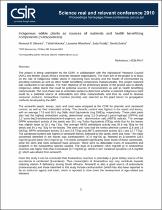 ResearchSpace
ResearchSpace
Indigenous edible plants as sources of nutrients and health benefitting components (nutraceuticals)
JavaScript is disabled for your browser. Some features of this site may not work without it.
- ResearchSpace
- →
- Research Publications/Outputs
- →
- Conference Publications
- →
- View Item
| dc.contributor.author |
Dlamini, N

|
|
| dc.contributor.author |
Moroka, T

|
|
| dc.contributor.author |
Mlotshwa, L

|
|
| dc.contributor.author |
Reddy, J

|
|
| dc.contributor.author |
Botha, G

|
|
| dc.date.accessioned | 2010-08-31T07:17:26Z | |
| dc.date.available | 2010-08-31T07:17:26Z | |
| dc.date.issued | 2010-08-31 | |
| dc.identifier.citation | Dlamini, N, et al. 2010. Indigenous edible plants as sources of nutrients and health benefitting components (nutraceuticals).CSIR 3rd biennial conference: 2010 science real and, relevant, CSIR International Convention Center, Pretoria, South Africa, 30 August-1 September 2010, pp 11 | en |
| dc.identifier.uri | http://hdl.handle.net/10204/4224 | |
| dc.description | CSIR 3rd biennial conference: 2010 science real and relevant, CSIR International Convention Center, Pretoria, South Africa, 30 August-1 September 2010. [Paper includes Conference Powerpoint Presentation] | en |
| dc.description.abstract | The project is being undertaken by the CSIR, in collaboration with the Agricultural Research Council (ARC) and Mintek (South Africa’s minerals research organisation). The main aim of the project is to focus on the role of indigenous edible plants in improving food security and the health of communities by providing nutrients as well as other health benefitting components (nutraceuticals). The project reported was conducted in two phases. The main objective of the preliminary phase of the project was to identify indigenous edible plants that could be potential sources of micronutrients as well as health benefitting nutraceuticals. The next phase was to undertake studies to determine whether a selected indigenous plant could be a potential source of antioxidants and other nutraceuticals, and thus be used to develop consumer products. Amaranthus cruentus (Arusha) was selected as the plant based on propagation methods developed by the ARC. | en |
| dc.language.iso | en | en |
| dc.publisher | CSIR | en |
| dc.subject | Indigenous edible plants | en |
| dc.subject | Nutrients | en |
| dc.subject | Health | en |
| dc.subject | Nutraceuticals | en |
| dc.subject | South Africa’s minerals research organisation | en |
| dc.subject | Mintek | en |
| dc.subject | Agricultural Research Council | en |
| dc.subject | ARC | en |
| dc.subject | CSIR Conference 2010 | en |
| dc.title | Indigenous edible plants as sources of nutrients and health benefitting components (nutraceuticals) | en |
| dc.type | Conference Presentation | en |
| dc.identifier.apacitation | Dlamini, N., Moroka, T., Mlotshwa, L., Reddy, J., & Botha, G. (2010). Indigenous edible plants as sources of nutrients and health benefitting components (nutraceuticals). CSIR. http://hdl.handle.net/10204/4224 | en_ZA |
| dc.identifier.chicagocitation | Dlamini, N, T Moroka, L Mlotshwa, J Reddy, and G Botha. "Indigenous edible plants as sources of nutrients and health benefitting components (nutraceuticals)." (2010): http://hdl.handle.net/10204/4224 | en_ZA |
| dc.identifier.vancouvercitation | Dlamini N, Moroka T, Mlotshwa L, Reddy J, Botha G, Indigenous edible plants as sources of nutrients and health benefitting components (nutraceuticals); CSIR; 2010. http://hdl.handle.net/10204/4224 . | en_ZA |
| dc.identifier.ris | TY - Conference Presentation AU - Dlamini, N AU - Moroka, T AU - Mlotshwa, L AU - Reddy, J AU - Botha, G AB - The project is being undertaken by the CSIR, in collaboration with the Agricultural Research Council (ARC) and Mintek (South Africa’s minerals research organisation). The main aim of the project is to focus on the role of indigenous edible plants in improving food security and the health of communities by providing nutrients as well as other health benefitting components (nutraceuticals). The project reported was conducted in two phases. The main objective of the preliminary phase of the project was to identify indigenous edible plants that could be potential sources of micronutrients as well as health benefitting nutraceuticals. The next phase was to undertake studies to determine whether a selected indigenous plant could be a potential source of antioxidants and other nutraceuticals, and thus be used to develop consumer products. Amaranthus cruentus (Arusha) was selected as the plant based on propagation methods developed by the ARC. DA - 2010-08-31 DB - ResearchSpace DP - CSIR KW - Indigenous edible plants KW - Nutrients KW - Health KW - Nutraceuticals KW - South Africa’s minerals research organisation KW - Mintek KW - Agricultural Research Council KW - ARC KW - CSIR Conference 2010 LK - https://researchspace.csir.co.za PY - 2010 T1 - Indigenous edible plants as sources of nutrients and health benefitting components (nutraceuticals) TI - Indigenous edible plants as sources of nutrients and health benefitting components (nutraceuticals) UR - http://hdl.handle.net/10204/4224 ER - | en_ZA |






